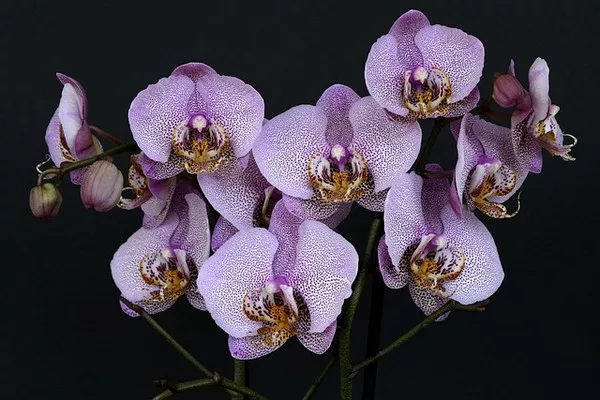Orchids, with their stunning array of colors and intricate blooms, are beloved by many plant enthusiasts. However, frustration can arise when an orchid produces lush foliage but fails to bloom. This phenomenon often leaves growers perplexed and searching for answers. Understanding why orchids might grow leaves but no flowers requires delving into various factors, including environmental conditions, cultural practices, and the unique nature of these captivating plants.
The Intricacies of Orchid Flowering
Before delving into the reasons behind the absence of blooms on orchids, it’s crucial to grasp the complexities of their flowering process. Unlike many other flowering plants, orchids have evolved unique mechanisms for reproduction. Their flowers are often highly specialized, with intricate structures that facilitate pollination by specific pollinators.
Orchids typically require specific environmental cues to initiate flowering. Factors such as temperature fluctuations, light intensity, and day-length play critical roles in triggering the flowering process. Furthermore, some orchid species have specific requirements regarding these environmental factors, making them more sensitive to changes in their surroundings.
Environmental Factors Impacting Flowering
One of the primary reasons orchids may fail to bloom is inadequate light. Insufficient light levels can hinder the plant’s ability to photosynthesize effectively, leading to poor energy reserves for flower production. Different orchid species have varying light requirements, with some needing bright, indirect light, while others thrive in lower light conditions. Assessing the specific light needs of your orchid and providing appropriate illumination is essential for encouraging flowering.
Conversely, excessive light exposure can also inhibit flowering in some orchids. Too much direct sunlight can lead to leaf burn and stress the plant, diverting resources away from flower production. Finding the right balance of light intensity is crucial for promoting healthy growth and blooming in orchids.
In addition to light, temperature fluctuations can significantly impact orchid flowering. Many orchid species require distinct day and night temperature differentials to stimulate flower initiation. Sudden changes in temperature or prolonged exposure to extremes can disrupt this process, leading to a lack of blooms. Ensuring stable temperature conditions within the orchid’s preferred range is vital for encouraging flowering.
Cultural Practices and Care Mistakes
Beyond environmental factors, cultural practices and care routines can also influence an orchid’s ability to bloom. Improper watering is a common culprit behind non-flowering orchids. Overwatering can lead to root rot and fungal issues, depriving the plant of essential nutrients and oxygen. Conversely, underwatering can result in dehydration and stress, impeding flower development. Finding the right balance of moisture is crucial for maintaining optimal orchid health and promoting flowering.
Furthermore, inadequate fertilization can hinder flower production in orchids. These plants have specific nutritional needs, with deficiencies or imbalances in essential nutrients affecting overall growth and flowering. Providing a balanced fertilizer regimen tailored to the orchid’s requirements can help ensure adequate nutrition for blooming.
Potting media and container selection can also impact orchid flowering. Improper drainage or compaction of the potting medium can lead to root suffocation and hinder nutrient uptake, inhibiting flower development. Choosing a well-draining potting mix and appropriate container size is essential for maintaining healthy root growth and facilitating flowering.
Understanding Orchid Species and Varieties
It’s essential to recognize that not all orchids bloom on the same schedule or under identical conditions. Different orchid species and varieties have unique flowering patterns and requirements. Some may bloom only once a year, while others may produce flowers multiple times annually. Additionally, certain orchids may undergo a dormancy period during which they do not flower.
Researching the specific needs and flowering habits of your orchid species is crucial for understanding its behavior. Consulting reputable sources or orchid experts can provide valuable insights into the optimal care and conditions for encouraging flowering in your particular orchid variety.
Patience and Persistence: Key to Orchid Success
In the quest to encourage orchid flowering, patience and persistence are paramount. Orchids, with their intricate biology and sensitivity to environmental cues, may require time and experimentation to thrive and bloom consistently. By carefully monitoring environmental conditions, implementing proper cultural practices, and understanding the unique characteristics of your orchid species, you can increase the likelihood of enjoying vibrant blooms year-round.
Conclusion
In conclusion, the absence of flowers on orchids despite lush leaf growth can be attributed to a variety of factors, including environmental conditions, cultural practices, and the inherent complexity of these captivating plants. By addressing potential issues such as inadequate light, improper watering, and nutritional deficiencies, growers can create optimal conditions for orchid flowering. Furthermore, understanding the specific needs and behaviors of your orchid species is essential for fostering healthy growth and consistent blooming. With dedication and a deeper understanding of orchid care, enthusiasts can unlock the mystery of why their orchids grow leaves but no flowers, ultimately enjoying the beauty and splendor of these remarkable plants.


